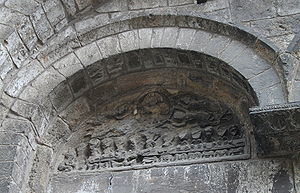
Saint-Pons-de-Thomières Cathedral
Encyclopedia

France
The French Republic , The French Republic , The French Republic , (commonly known as France , is a unitary semi-presidential republic in Western Europe with several overseas territories and islands located on other continents and in the Indian, Pacific, and Atlantic oceans. Metropolitan France...
, in Saint-Pons-de-Thomières
Saint-Pons-de-Thomières
Saint-Pons-de-Thomières is a commune in the Hérault department in Languedoc-Roussillon in southern France.-History:It is named after its patron saint, St...
.
It was formerly the seat of the Bishopric of Saint-Pons, founded like a number of bishoprics in the region in the aftermath of the suppression of the Albigensians. By a Papal bull
Papal bull
A Papal bull is a particular type of letters patent or charter issued by a Pope of the Catholic Church. It is named after the bulla that was appended to the end in order to authenticate it....
dated 18 February 1318, Pope John XXII
Pope John XXII
Pope John XXII , born Jacques Duèze , was pope from 1316 to 1334. He was the second Pope of the Avignon Papacy , elected by a conclave in Lyon assembled by Philip V of France...
created the see by elevating the abbey of Saint-Pons, which had been here since its foundation in 936 by Raymond, Count of Toulouse
Raymond Pons of Toulouse
Raymond Pons was the Count of Toulouse from 924. He was the last head of his house to rule in Toulouse before the power passed to his cousins the counts of Rouergue....
. The bishopric was abolished by the Concordat of 1801
Concordat of 1801
The Concordat of 1801 was an agreement between Napoleon and Pope Pius VII, signed on 15 July 1801. It solidified the Roman Catholic Church as the majority church of France and brought back most of its civil status....
and merged into the Diocese of Montpellier.

Romanesque architecture
Romanesque architecture is an architectural style of Medieval Europe characterised by semi-circular arches. There is no consensus for the beginning date of the Romanesque architecture, with proposals ranging from the 6th to the 10th century. It developed in the 12th century into the Gothic style,...
abbey church became the present cathedral. It takes its dedication, like the town and the abbey, from Saint Pontius of Cimiez. It is particularly known for the carvings on and around the portals. During the French Wars of Religion
French Wars of Religion
The French Wars of Religion is the name given to a period of civil infighting and military operations, primarily fought between French Catholics and Protestants . The conflict involved the factional disputes between the aristocratic houses of France, such as the House of Bourbon and House of Guise...
the choir was destroyed; it was replaced with the present neo-classical
Neoclassical architecture
Neoclassical architecture was an architectural style produced by the neoclassical movement that began in the mid-18th century, manifested both in its details as a reaction against the Rococo style of naturalistic ornament, and in its architectural formulas as an outgrowth of some classicizing...
east front.

